Critical Appraisal of a Trial on High Flow Humidified Oxygen for Bronchiolitis
VerifiedAdded on 2023/04/08
|13
|2400
|182
AI Summary
This document provides a critical appraisal of a trial conducted on the efficacy of high flow humidified oxygen (HFWHO) as a respiratory support for bronchiolitis. It discusses the population, intervention, comparator, outcomes, and limitations of the study.
Contribute Materials
Your contribution can guide someone’s learning journey. Share your
documents today.
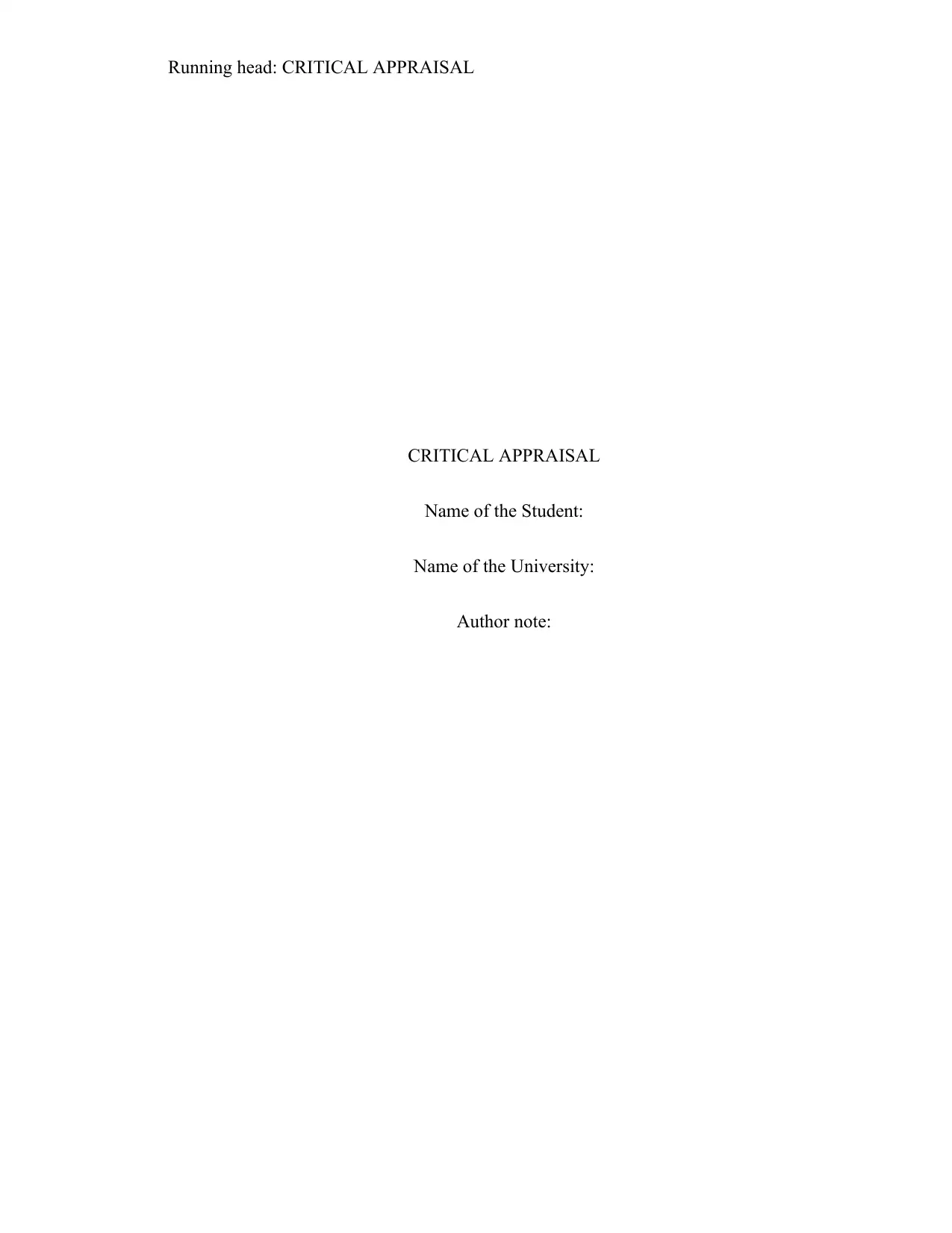
Running head: CRITICAL APPRAISAL
CRITICAL APPRAISAL
Name of the Student:
Name of the University:
Author note:
CRITICAL APPRAISAL
Name of the Student:
Name of the University:
Author note:
Secure Best Marks with AI Grader
Need help grading? Try our AI Grader for instant feedback on your assignments.
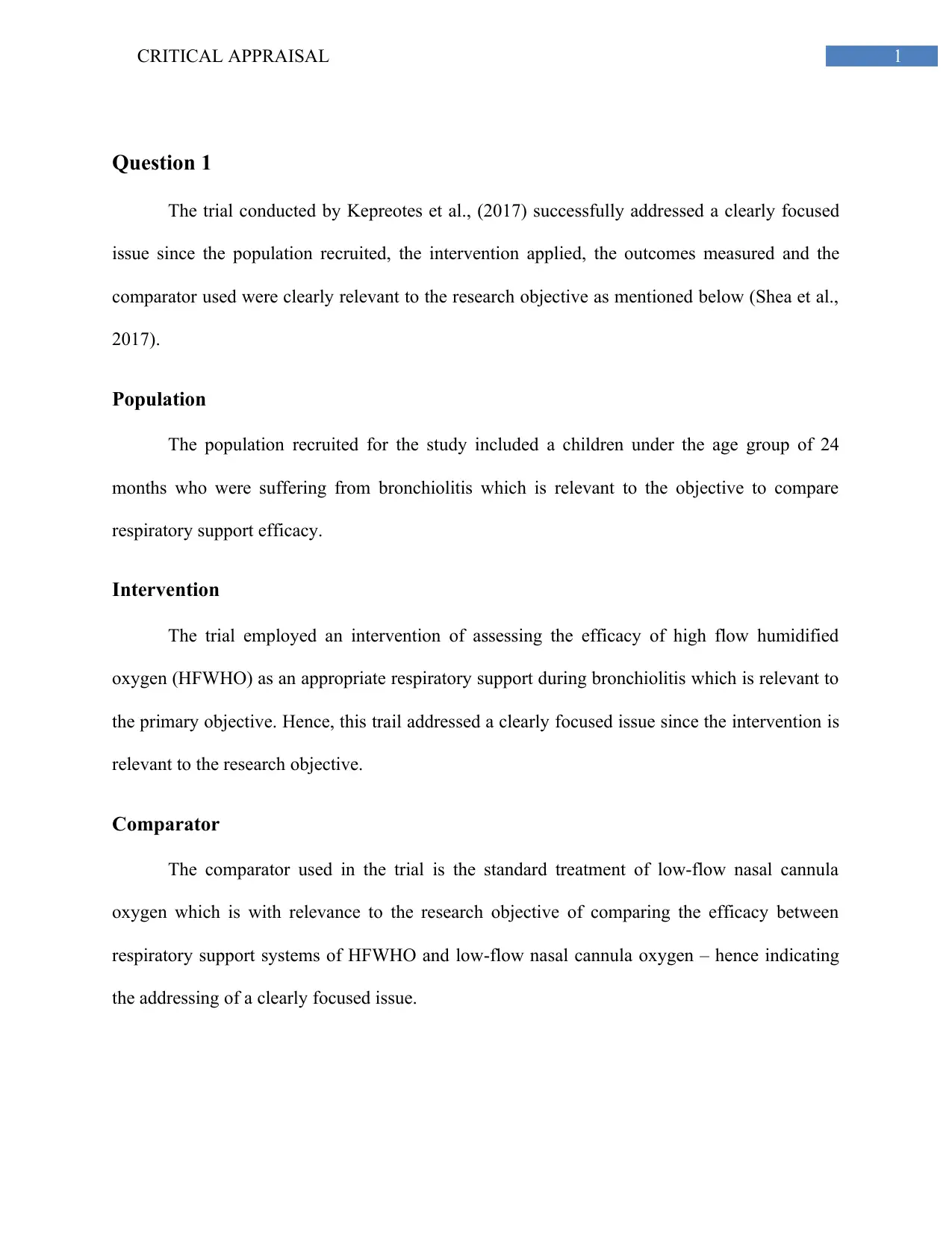
1CRITICAL APPRAISAL
Question 1
The trial conducted by Kepreotes et al., (2017) successfully addressed a clearly focused
issue since the population recruited, the intervention applied, the outcomes measured and the
comparator used were clearly relevant to the research objective as mentioned below (Shea et al.,
2017).
Population
The population recruited for the study included a children under the age group of 24
months who were suffering from bronchiolitis which is relevant to the objective to compare
respiratory support efficacy.
Intervention
The trial employed an intervention of assessing the efficacy of high flow humidified
oxygen (HFWHO) as an appropriate respiratory support during bronchiolitis which is relevant to
the primary objective. Hence, this trail addressed a clearly focused issue since the intervention is
relevant to the research objective.
Comparator
The comparator used in the trial is the standard treatment of low-flow nasal cannula
oxygen which is with relevance to the research objective of comparing the efficacy between
respiratory support systems of HFWHO and low-flow nasal cannula oxygen – hence indicating
the addressing of a clearly focused issue.
Question 1
The trial conducted by Kepreotes et al., (2017) successfully addressed a clearly focused
issue since the population recruited, the intervention applied, the outcomes measured and the
comparator used were clearly relevant to the research objective as mentioned below (Shea et al.,
2017).
Population
The population recruited for the study included a children under the age group of 24
months who were suffering from bronchiolitis which is relevant to the objective to compare
respiratory support efficacy.
Intervention
The trial employed an intervention of assessing the efficacy of high flow humidified
oxygen (HFWHO) as an appropriate respiratory support during bronchiolitis which is relevant to
the primary objective. Hence, this trail addressed a clearly focused issue since the intervention is
relevant to the research objective.
Comparator
The comparator used in the trial is the standard treatment of low-flow nasal cannula
oxygen which is with relevance to the research objective of comparing the efficacy between
respiratory support systems of HFWHO and low-flow nasal cannula oxygen – hence indicating
the addressing of a clearly focused issue.
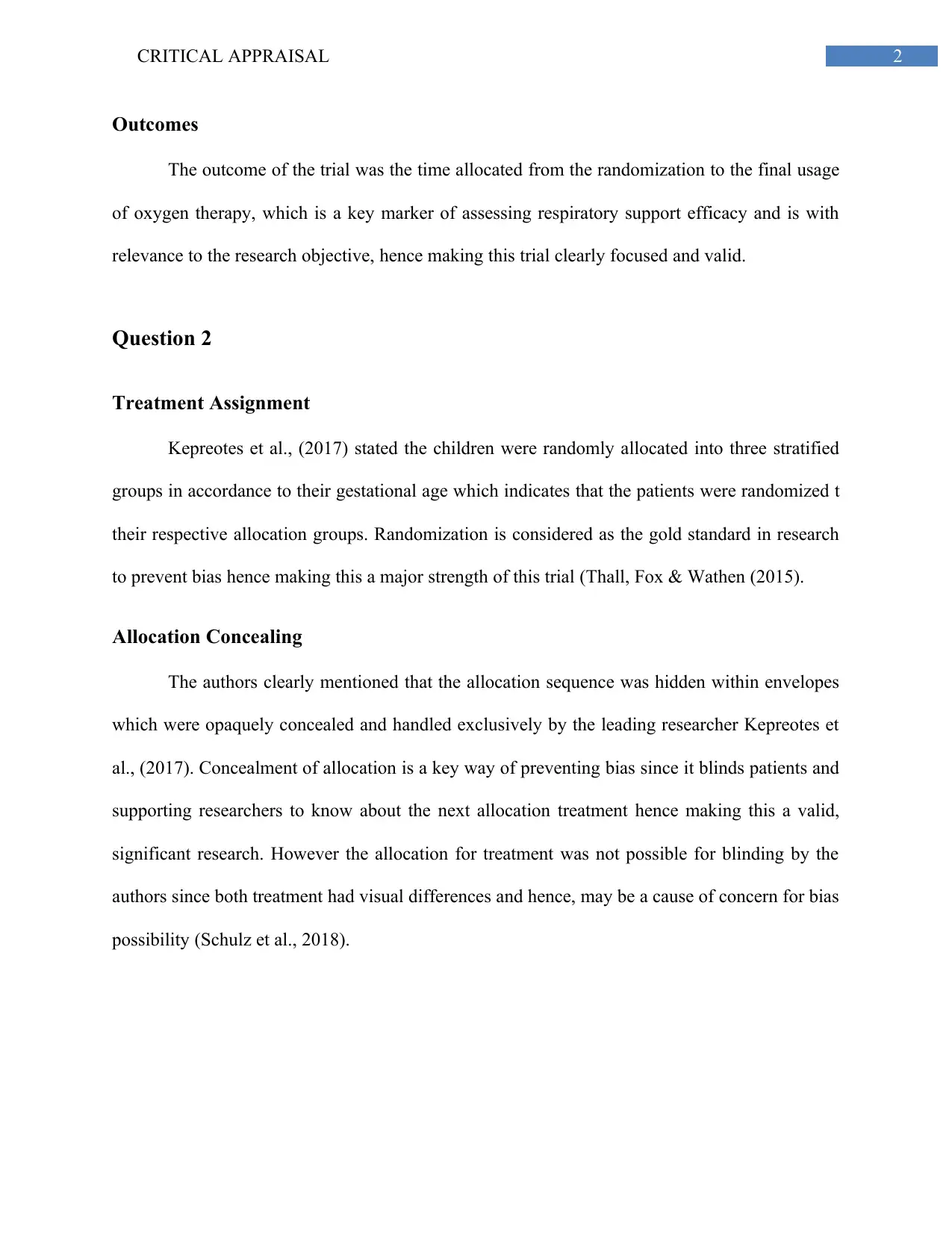
2CRITICAL APPRAISAL
Outcomes
The outcome of the trial was the time allocated from the randomization to the final usage
of oxygen therapy, which is a key marker of assessing respiratory support efficacy and is with
relevance to the research objective, hence making this trial clearly focused and valid.
Question 2
Treatment Assignment
Kepreotes et al., (2017) stated the children were randomly allocated into three stratified
groups in accordance to their gestational age which indicates that the patients were randomized t
their respective allocation groups. Randomization is considered as the gold standard in research
to prevent bias hence making this a major strength of this trial (Thall, Fox & Wathen (2015).
Allocation Concealing
The authors clearly mentioned that the allocation sequence was hidden within envelopes
which were opaquely concealed and handled exclusively by the leading researcher Kepreotes et
al., (2017). Concealment of allocation is a key way of preventing bias since it blinds patients and
supporting researchers to know about the next allocation treatment hence making this a valid,
significant research. However the allocation for treatment was not possible for blinding by the
authors since both treatment had visual differences and hence, may be a cause of concern for bias
possibility (Schulz et al., 2018).
Outcomes
The outcome of the trial was the time allocated from the randomization to the final usage
of oxygen therapy, which is a key marker of assessing respiratory support efficacy and is with
relevance to the research objective, hence making this trial clearly focused and valid.
Question 2
Treatment Assignment
Kepreotes et al., (2017) stated the children were randomly allocated into three stratified
groups in accordance to their gestational age which indicates that the patients were randomized t
their respective allocation groups. Randomization is considered as the gold standard in research
to prevent bias hence making this a major strength of this trial (Thall, Fox & Wathen (2015).
Allocation Concealing
The authors clearly mentioned that the allocation sequence was hidden within envelopes
which were opaquely concealed and handled exclusively by the leading researcher Kepreotes et
al., (2017). Concealment of allocation is a key way of preventing bias since it blinds patients and
supporting researchers to know about the next allocation treatment hence making this a valid,
significant research. However the allocation for treatment was not possible for blinding by the
authors since both treatment had visual differences and hence, may be a cause of concern for bias
possibility (Schulz et al., 2018).
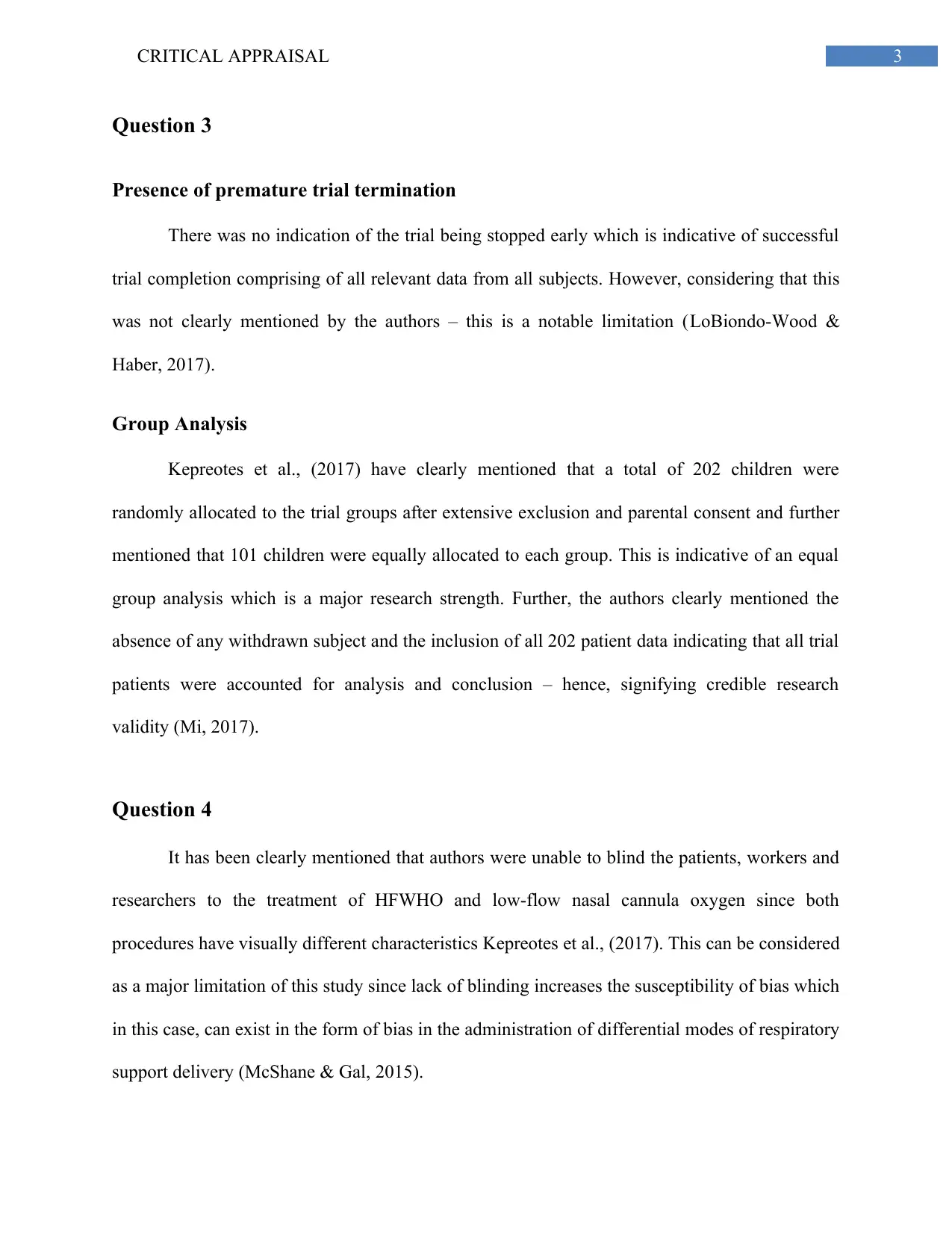
3CRITICAL APPRAISAL
Question 3
Presence of premature trial termination
There was no indication of the trial being stopped early which is indicative of successful
trial completion comprising of all relevant data from all subjects. However, considering that this
was not clearly mentioned by the authors – this is a notable limitation (LoBiondo-Wood &
Haber, 2017).
Group Analysis
Kepreotes et al., (2017) have clearly mentioned that a total of 202 children were
randomly allocated to the trial groups after extensive exclusion and parental consent and further
mentioned that 101 children were equally allocated to each group. This is indicative of an equal
group analysis which is a major research strength. Further, the authors clearly mentioned the
absence of any withdrawn subject and the inclusion of all 202 patient data indicating that all trial
patients were accounted for analysis and conclusion – hence, signifying credible research
validity (Mi, 2017).
Question 4
It has been clearly mentioned that authors were unable to blind the patients, workers and
researchers to the treatment of HFWHO and low-flow nasal cannula oxygen since both
procedures have visually different characteristics Kepreotes et al., (2017). This can be considered
as a major limitation of this study since lack of blinding increases the susceptibility of bias which
in this case, can exist in the form of bias in the administration of differential modes of respiratory
support delivery (McShane & Gal, 2015).
Question 3
Presence of premature trial termination
There was no indication of the trial being stopped early which is indicative of successful
trial completion comprising of all relevant data from all subjects. However, considering that this
was not clearly mentioned by the authors – this is a notable limitation (LoBiondo-Wood &
Haber, 2017).
Group Analysis
Kepreotes et al., (2017) have clearly mentioned that a total of 202 children were
randomly allocated to the trial groups after extensive exclusion and parental consent and further
mentioned that 101 children were equally allocated to each group. This is indicative of an equal
group analysis which is a major research strength. Further, the authors clearly mentioned the
absence of any withdrawn subject and the inclusion of all 202 patient data indicating that all trial
patients were accounted for analysis and conclusion – hence, signifying credible research
validity (Mi, 2017).
Question 4
It has been clearly mentioned that authors were unable to blind the patients, workers and
researchers to the treatment of HFWHO and low-flow nasal cannula oxygen since both
procedures have visually different characteristics Kepreotes et al., (2017). This can be considered
as a major limitation of this study since lack of blinding increases the susceptibility of bias which
in this case, can exist in the form of bias in the administration of differential modes of respiratory
support delivery (McShane & Gal, 2015).
Secure Best Marks with AI Grader
Need help grading? Try our AI Grader for instant feedback on your assignments.

4CRITICAL APPRAISAL
Question 5
Kepreotes et al., (2017) clearly mentioned that the participant aged under the age group
of 24 months and suffering from bronchiolitis were recruited for the trial, indicating similarity in
subject characteristics – a major strength of this study. However, the authors also stated in Table
1 of the research that the recruited children were stratified to three groups of gestational age,
comprised of Australian as well as mixed ethnic background and comprised of unequal gender
distribution. Hence, such mixed characteristics may be considered as a major limitation due to
possibility of heterogeneity in trial outcome results (Buccheri & Sharifi et al., 2017).
Question 6
In addition to the treatment interventions, Kepreotes et al., (2017) clearly mentioned that
the patients were provided with equal treatment during the trial in the form of using a
standardized procedure for weaning from oxygen for both groups formulated by the New South
Wales Ministry of Health and Clinical Excellence. Such equality in treatment is a major strength
of this study since it reduces the possibility of bias in performance by the researches and health
workers (Smith & Noble, 2014).
Question 7
The treatment effect of the trial was significantly large due to measurement of wide
variety of outcomes, specification of the primary outcome and reporting of results of each
outcome, which is indicates high validity as mentioned in the following (Kepreotes et al., 2017).
However, inadequate reporting of parental outcomes can be considered as a limitation (Elwood,
2017).
Question 5
Kepreotes et al., (2017) clearly mentioned that the participant aged under the age group
of 24 months and suffering from bronchiolitis were recruited for the trial, indicating similarity in
subject characteristics – a major strength of this study. However, the authors also stated in Table
1 of the research that the recruited children were stratified to three groups of gestational age,
comprised of Australian as well as mixed ethnic background and comprised of unequal gender
distribution. Hence, such mixed characteristics may be considered as a major limitation due to
possibility of heterogeneity in trial outcome results (Buccheri & Sharifi et al., 2017).
Question 6
In addition to the treatment interventions, Kepreotes et al., (2017) clearly mentioned that
the patients were provided with equal treatment during the trial in the form of using a
standardized procedure for weaning from oxygen for both groups formulated by the New South
Wales Ministry of Health and Clinical Excellence. Such equality in treatment is a major strength
of this study since it reduces the possibility of bias in performance by the researches and health
workers (Smith & Noble, 2014).
Question 7
The treatment effect of the trial was significantly large due to measurement of wide
variety of outcomes, specification of the primary outcome and reporting of results of each
outcome, which is indicates high validity as mentioned in the following (Kepreotes et al., 2017).
However, inadequate reporting of parental outcomes can be considered as a limitation (Elwood,
2017).
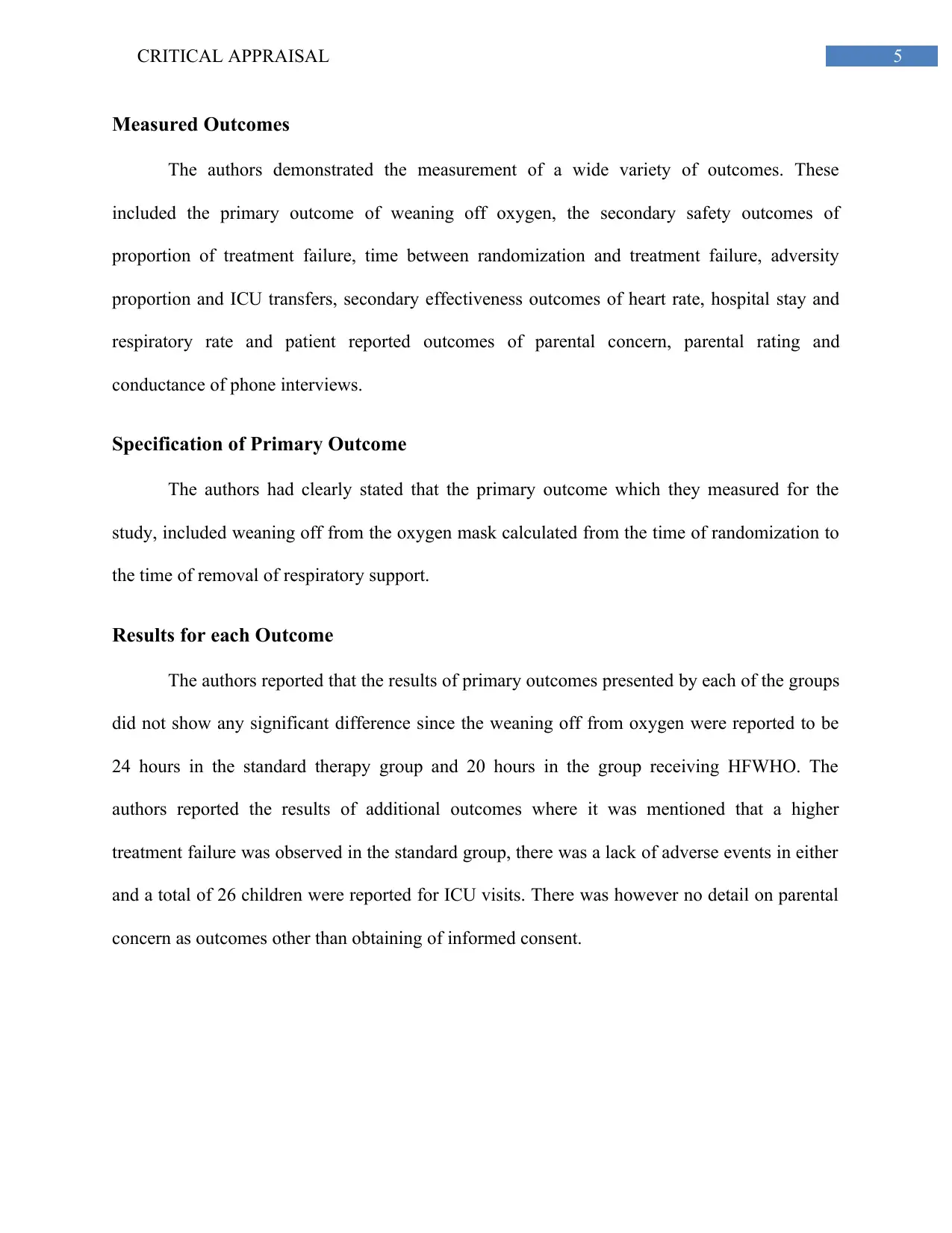
5CRITICAL APPRAISAL
Measured Outcomes
The authors demonstrated the measurement of a wide variety of outcomes. These
included the primary outcome of weaning off oxygen, the secondary safety outcomes of
proportion of treatment failure, time between randomization and treatment failure, adversity
proportion and ICU transfers, secondary effectiveness outcomes of heart rate, hospital stay and
respiratory rate and patient reported outcomes of parental concern, parental rating and
conductance of phone interviews.
Specification of Primary Outcome
The authors had clearly stated that the primary outcome which they measured for the
study, included weaning off from the oxygen mask calculated from the time of randomization to
the time of removal of respiratory support.
Results for each Outcome
The authors reported that the results of primary outcomes presented by each of the groups
did not show any significant difference since the weaning off from oxygen were reported to be
24 hours in the standard therapy group and 20 hours in the group receiving HFWHO. The
authors reported the results of additional outcomes where it was mentioned that a higher
treatment failure was observed in the standard group, there was a lack of adverse events in either
and a total of 26 children were reported for ICU visits. There was however no detail on parental
concern as outcomes other than obtaining of informed consent.
Measured Outcomes
The authors demonstrated the measurement of a wide variety of outcomes. These
included the primary outcome of weaning off oxygen, the secondary safety outcomes of
proportion of treatment failure, time between randomization and treatment failure, adversity
proportion and ICU transfers, secondary effectiveness outcomes of heart rate, hospital stay and
respiratory rate and patient reported outcomes of parental concern, parental rating and
conductance of phone interviews.
Specification of Primary Outcome
The authors had clearly stated that the primary outcome which they measured for the
study, included weaning off from the oxygen mask calculated from the time of randomization to
the time of removal of respiratory support.
Results for each Outcome
The authors reported that the results of primary outcomes presented by each of the groups
did not show any significant difference since the weaning off from oxygen were reported to be
24 hours in the standard therapy group and 20 hours in the group receiving HFWHO. The
authors reported the results of additional outcomes where it was mentioned that a higher
treatment failure was observed in the standard group, there was a lack of adverse events in either
and a total of 26 children were reported for ICU visits. There was however no detail on parental
concern as outcomes other than obtaining of informed consent.

6CRITICAL APPRAISAL
Question 8
As observed from the results report, Kepreotes et al., (2017) indicated the effectiveness of
the treatment using confidence limits of 95% for each group of receiving standard as well as
HFWHO therapy. This indicates an assurance of treatment efficacy with a confidence of 95%.
While this may be considered as a strength due to indication of statistically significant
effectiveness, it is still narrower with reduced accuracy in comparison to a confidence level of
99% (Lee, 2016).
Question 9
Patient Similarity
As observed from critical evaluation as well as by Kepreotes et al., (2017), the study
results may not be applicable to every situation of the local context due to its conductance of a
specific group of patients at a notable pediatric tertiary care center, which may be accessible and
affordable to only a selective population (Zeng et al., 2015).
Difference
The key difference remained in terms of disease severity where the trial primarily
included patients with moderate bronchiolitis and hence, may not be applicable to those with
severe conditions of this disease. Further, the results may be generalized since the trial recruited
only a specific group of patients at a single healthcare organization which may not be accessible
for all socioeconomic patient groups. Further, the authors noted that the HFWHO equipment was
more expensive hence indicating reduced applicability among economically underprivileged
groups and hence research limitation (Kepreotes et al., 2017).
Question 8
As observed from the results report, Kepreotes et al., (2017) indicated the effectiveness of
the treatment using confidence limits of 95% for each group of receiving standard as well as
HFWHO therapy. This indicates an assurance of treatment efficacy with a confidence of 95%.
While this may be considered as a strength due to indication of statistically significant
effectiveness, it is still narrower with reduced accuracy in comparison to a confidence level of
99% (Lee, 2016).
Question 9
Patient Similarity
As observed from critical evaluation as well as by Kepreotes et al., (2017), the study
results may not be applicable to every situation of the local context due to its conductance of a
specific group of patients at a notable pediatric tertiary care center, which may be accessible and
affordable to only a selective population (Zeng et al., 2015).
Difference
The key difference remained in terms of disease severity where the trial primarily
included patients with moderate bronchiolitis and hence, may not be applicable to those with
severe conditions of this disease. Further, the results may be generalized since the trial recruited
only a specific group of patients at a single healthcare organization which may not be accessible
for all socioeconomic patient groups. Further, the authors noted that the HFWHO equipment was
more expensive hence indicating reduced applicability among economically underprivileged
groups and hence research limitation (Kepreotes et al., 2017).
Paraphrase This Document
Need a fresh take? Get an instant paraphrase of this document with our AI Paraphraser

7CRITICAL APPRAISAL
Question 10
Other information
There seemed to be lack of information concerning the effectiveness of HFWHO therapy
on children with severe bronchiolitis since such subjects were excluded from the study
(Kepreotes et al., 2017).
Decision Affected
This can be considered as a major limitation concerning the rate of applicability of the
trial since the authors excluded severe disease groups and warned that lack of efficacy of
HFWHO against the same. Further, the lack of statistically significant results resulted in the
authors reporting that HFWHO treatment may only be applicable in moderate disease conditions
with previous compliance of this treatment. This is a limitation and affects future evidence based
decision making since this treatment seems to be applicable to only a limited patient group
(Ganie, Ahmad & Jain, 2018).
Question 11
The benefits may not be worth the cost since expensive HFWHO treatment did not
produce any statistically significant benefit as compared to standard therapy. Further,
considering the limited applicability and occurrence of moderate adversity, HFWHO may not be
beneficial for administration on severe bronchiolitis patients (Kepreotes et al., 2017).
Question 10
Other information
There seemed to be lack of information concerning the effectiveness of HFWHO therapy
on children with severe bronchiolitis since such subjects were excluded from the study
(Kepreotes et al., 2017).
Decision Affected
This can be considered as a major limitation concerning the rate of applicability of the
trial since the authors excluded severe disease groups and warned that lack of efficacy of
HFWHO against the same. Further, the lack of statistically significant results resulted in the
authors reporting that HFWHO treatment may only be applicable in moderate disease conditions
with previous compliance of this treatment. This is a limitation and affects future evidence based
decision making since this treatment seems to be applicable to only a limited patient group
(Ganie, Ahmad & Jain, 2018).
Question 11
The benefits may not be worth the cost since expensive HFWHO treatment did not
produce any statistically significant benefit as compared to standard therapy. Further,
considering the limited applicability and occurrence of moderate adversity, HFWHO may not be
beneficial for administration on severe bronchiolitis patients (Kepreotes et al., 2017).
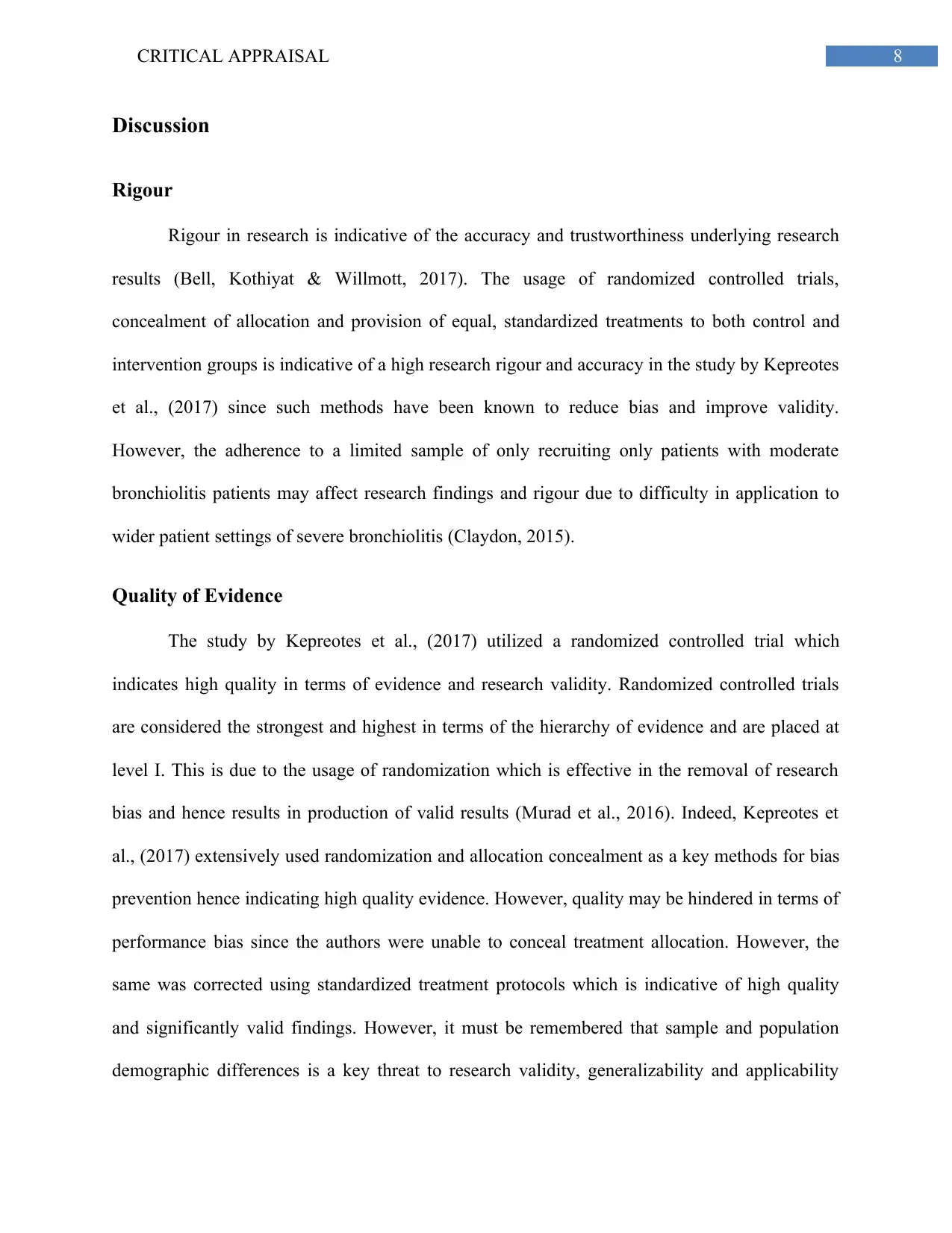
8CRITICAL APPRAISAL
Discussion
Rigour
Rigour in research is indicative of the accuracy and trustworthiness underlying research
results (Bell, Kothiyat & Willmott, 2017). The usage of randomized controlled trials,
concealment of allocation and provision of equal, standardized treatments to both control and
intervention groups is indicative of a high research rigour and accuracy in the study by Kepreotes
et al., (2017) since such methods have been known to reduce bias and improve validity.
However, the adherence to a limited sample of only recruiting only patients with moderate
bronchiolitis patients may affect research findings and rigour due to difficulty in application to
wider patient settings of severe bronchiolitis (Claydon, 2015).
Quality of Evidence
The study by Kepreotes et al., (2017) utilized a randomized controlled trial which
indicates high quality in terms of evidence and research validity. Randomized controlled trials
are considered the strongest and highest in terms of the hierarchy of evidence and are placed at
level I. This is due to the usage of randomization which is effective in the removal of research
bias and hence results in production of valid results (Murad et al., 2016). Indeed, Kepreotes et
al., (2017) extensively used randomization and allocation concealment as a key methods for bias
prevention hence indicating high quality evidence. However, quality may be hindered in terms of
performance bias since the authors were unable to conceal treatment allocation. However, the
same was corrected using standardized treatment protocols which is indicative of high quality
and significantly valid findings. However, it must be remembered that sample and population
demographic differences is a key threat to research validity, generalizability and applicability
Discussion
Rigour
Rigour in research is indicative of the accuracy and trustworthiness underlying research
results (Bell, Kothiyat & Willmott, 2017). The usage of randomized controlled trials,
concealment of allocation and provision of equal, standardized treatments to both control and
intervention groups is indicative of a high research rigour and accuracy in the study by Kepreotes
et al., (2017) since such methods have been known to reduce bias and improve validity.
However, the adherence to a limited sample of only recruiting only patients with moderate
bronchiolitis patients may affect research findings and rigour due to difficulty in application to
wider patient settings of severe bronchiolitis (Claydon, 2015).
Quality of Evidence
The study by Kepreotes et al., (2017) utilized a randomized controlled trial which
indicates high quality in terms of evidence and research validity. Randomized controlled trials
are considered the strongest and highest in terms of the hierarchy of evidence and are placed at
level I. This is due to the usage of randomization which is effective in the removal of research
bias and hence results in production of valid results (Murad et al., 2016). Indeed, Kepreotes et
al., (2017) extensively used randomization and allocation concealment as a key methods for bias
prevention hence indicating high quality evidence. However, quality may be hindered in terms of
performance bias since the authors were unable to conceal treatment allocation. However, the
same was corrected using standardized treatment protocols which is indicative of high quality
and significantly valid findings. However, it must be remembered that sample and population
demographic differences is a key threat to research validity, generalizability and applicability

9CRITICAL APPRAISAL
which can be observed in the authors assessment of patients with only moderate bronchiolitis and
exclusion of severe cases – hence hindering quality (Heale & Twycross, 2015).
Additional Critique
A key criticism which must be considered in the research by Kepreotes et al., (2017) is its
generalizability of findings which may hinder research quality, validity and applicability in real
life settings. It has been observed that the authors excluded patients with severe disease
conditions and only included those with moderate symptoms. This coupled with a lack of
statistically significant results lead to a difficulty in applying this intervention in patient with
severe bronchiolitis symptoms or even in moderate disease conditions with complete confidence.
Further, the trial was conducted only in a single healthcare organization catering to a specific
population type. This coupled with the high expenses of HFWHO makes this trial difficult to
consider as a standard treatment in low income group patients. Hence, evaluation of HFWHO in
varied demographic and disease conditions could have enhanced the quality and validity of this
study (Noble & Smith, 2015).
which can be observed in the authors assessment of patients with only moderate bronchiolitis and
exclusion of severe cases – hence hindering quality (Heale & Twycross, 2015).
Additional Critique
A key criticism which must be considered in the research by Kepreotes et al., (2017) is its
generalizability of findings which may hinder research quality, validity and applicability in real
life settings. It has been observed that the authors excluded patients with severe disease
conditions and only included those with moderate symptoms. This coupled with a lack of
statistically significant results lead to a difficulty in applying this intervention in patient with
severe bronchiolitis symptoms or even in moderate disease conditions with complete confidence.
Further, the trial was conducted only in a single healthcare organization catering to a specific
population type. This coupled with the high expenses of HFWHO makes this trial difficult to
consider as a standard treatment in low income group patients. Hence, evaluation of HFWHO in
varied demographic and disease conditions could have enhanced the quality and validity of this
study (Noble & Smith, 2015).
Secure Best Marks with AI Grader
Need help grading? Try our AI Grader for instant feedback on your assignments.
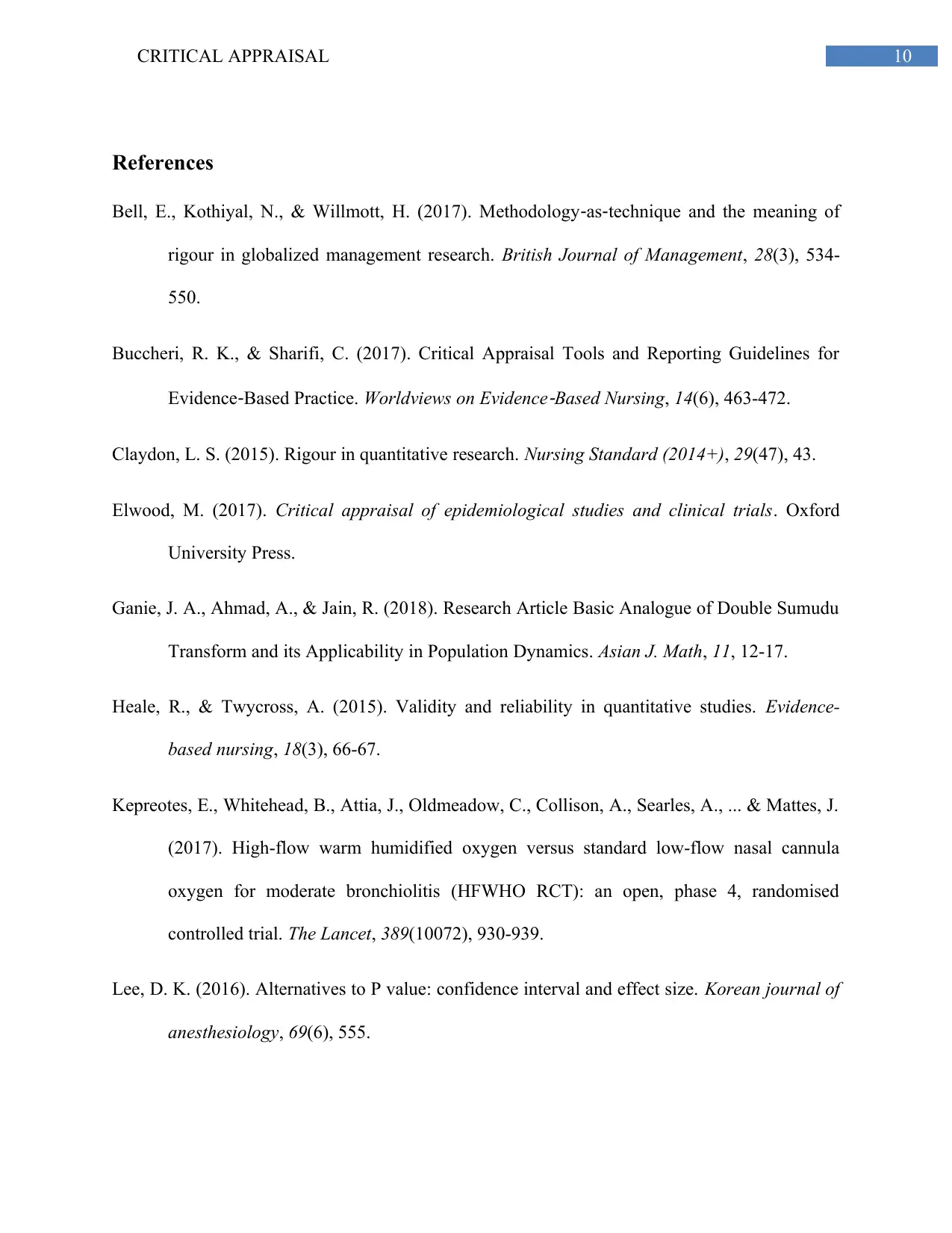
10CRITICAL APPRAISAL
References
Bell, E., Kothiyal, N., & Willmott, H. (2017). Methodology‐as‐technique and the meaning of
rigour in globalized management research. British Journal of Management, 28(3), 534-
550.
Buccheri, R. K., & Sharifi, C. (2017). Critical Appraisal Tools and Reporting Guidelines for
Evidence‐Based Practice. Worldviews on Evidence
‐Based Nursing, 14(6), 463-472.
Claydon, L. S. (2015). Rigour in quantitative research. Nursing Standard (2014+), 29(47), 43.
Elwood, M. (2017). Critical appraisal of epidemiological studies and clinical trials. Oxford
University Press.
Ganie, J. A., Ahmad, A., & Jain, R. (2018). Research Article Basic Analogue of Double Sumudu
Transform and its Applicability in Population Dynamics. Asian J. Math, 11, 12-17.
Heale, R., & Twycross, A. (2015). Validity and reliability in quantitative studies. Evidence-
based nursing, 18(3), 66-67.
Kepreotes, E., Whitehead, B., Attia, J., Oldmeadow, C., Collison, A., Searles, A., ... & Mattes, J.
(2017). High-flow warm humidified oxygen versus standard low-flow nasal cannula
oxygen for moderate bronchiolitis (HFWHO RCT): an open, phase 4, randomised
controlled trial. The Lancet, 389(10072), 930-939.
Lee, D. K. (2016). Alternatives to P value: confidence interval and effect size. Korean journal of
anesthesiology, 69(6), 555.
References
Bell, E., Kothiyal, N., & Willmott, H. (2017). Methodology‐as‐technique and the meaning of
rigour in globalized management research. British Journal of Management, 28(3), 534-
550.
Buccheri, R. K., & Sharifi, C. (2017). Critical Appraisal Tools and Reporting Guidelines for
Evidence‐Based Practice. Worldviews on Evidence
‐Based Nursing, 14(6), 463-472.
Claydon, L. S. (2015). Rigour in quantitative research. Nursing Standard (2014+), 29(47), 43.
Elwood, M. (2017). Critical appraisal of epidemiological studies and clinical trials. Oxford
University Press.
Ganie, J. A., Ahmad, A., & Jain, R. (2018). Research Article Basic Analogue of Double Sumudu
Transform and its Applicability in Population Dynamics. Asian J. Math, 11, 12-17.
Heale, R., & Twycross, A. (2015). Validity and reliability in quantitative studies. Evidence-
based nursing, 18(3), 66-67.
Kepreotes, E., Whitehead, B., Attia, J., Oldmeadow, C., Collison, A., Searles, A., ... & Mattes, J.
(2017). High-flow warm humidified oxygen versus standard low-flow nasal cannula
oxygen for moderate bronchiolitis (HFWHO RCT): an open, phase 4, randomised
controlled trial. The Lancet, 389(10072), 930-939.
Lee, D. K. (2016). Alternatives to P value: confidence interval and effect size. Korean journal of
anesthesiology, 69(6), 555.
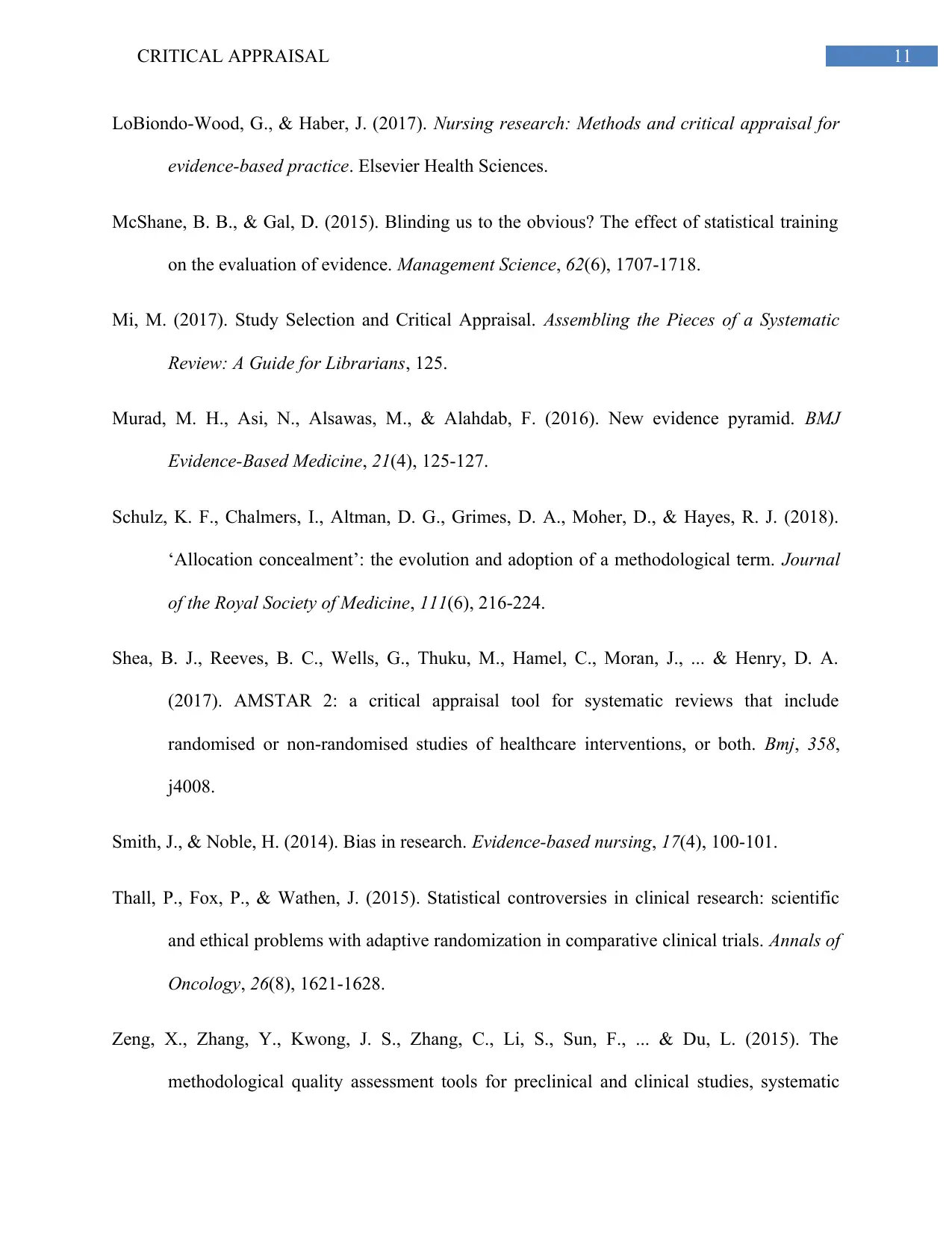
11CRITICAL APPRAISAL
LoBiondo-Wood, G., & Haber, J. (2017). Nursing research: Methods and critical appraisal for
evidence-based practice. Elsevier Health Sciences.
McShane, B. B., & Gal, D. (2015). Blinding us to the obvious? The effect of statistical training
on the evaluation of evidence. Management Science, 62(6), 1707-1718.
Mi, M. (2017). Study Selection and Critical Appraisal. Assembling the Pieces of a Systematic
Review: A Guide for Librarians, 125.
Murad, M. H., Asi, N., Alsawas, M., & Alahdab, F. (2016). New evidence pyramid. BMJ
Evidence-Based Medicine, 21(4), 125-127.
Schulz, K. F., Chalmers, I., Altman, D. G., Grimes, D. A., Moher, D., & Hayes, R. J. (2018).
‘Allocation concealment’: the evolution and adoption of a methodological term. Journal
of the Royal Society of Medicine, 111(6), 216-224.
Shea, B. J., Reeves, B. C., Wells, G., Thuku, M., Hamel, C., Moran, J., ... & Henry, D. A.
(2017). AMSTAR 2: a critical appraisal tool for systematic reviews that include
randomised or non-randomised studies of healthcare interventions, or both. Bmj, 358,
j4008.
Smith, J., & Noble, H. (2014). Bias in research. Evidence-based nursing, 17(4), 100-101.
Thall, P., Fox, P., & Wathen, J. (2015). Statistical controversies in clinical research: scientific
and ethical problems with adaptive randomization in comparative clinical trials. Annals of
Oncology, 26(8), 1621-1628.
Zeng, X., Zhang, Y., Kwong, J. S., Zhang, C., Li, S., Sun, F., ... & Du, L. (2015). The
methodological quality assessment tools for preclinical and clinical studies, systematic
LoBiondo-Wood, G., & Haber, J. (2017). Nursing research: Methods and critical appraisal for
evidence-based practice. Elsevier Health Sciences.
McShane, B. B., & Gal, D. (2015). Blinding us to the obvious? The effect of statistical training
on the evaluation of evidence. Management Science, 62(6), 1707-1718.
Mi, M. (2017). Study Selection and Critical Appraisal. Assembling the Pieces of a Systematic
Review: A Guide for Librarians, 125.
Murad, M. H., Asi, N., Alsawas, M., & Alahdab, F. (2016). New evidence pyramid. BMJ
Evidence-Based Medicine, 21(4), 125-127.
Schulz, K. F., Chalmers, I., Altman, D. G., Grimes, D. A., Moher, D., & Hayes, R. J. (2018).
‘Allocation concealment’: the evolution and adoption of a methodological term. Journal
of the Royal Society of Medicine, 111(6), 216-224.
Shea, B. J., Reeves, B. C., Wells, G., Thuku, M., Hamel, C., Moran, J., ... & Henry, D. A.
(2017). AMSTAR 2: a critical appraisal tool for systematic reviews that include
randomised or non-randomised studies of healthcare interventions, or both. Bmj, 358,
j4008.
Smith, J., & Noble, H. (2014). Bias in research. Evidence-based nursing, 17(4), 100-101.
Thall, P., Fox, P., & Wathen, J. (2015). Statistical controversies in clinical research: scientific
and ethical problems with adaptive randomization in comparative clinical trials. Annals of
Oncology, 26(8), 1621-1628.
Zeng, X., Zhang, Y., Kwong, J. S., Zhang, C., Li, S., Sun, F., ... & Du, L. (2015). The
methodological quality assessment tools for preclinical and clinical studies, systematic

12CRITICAL APPRAISAL
review and meta‐analysis, and clinical practice guideline: a systematic review. Journal of
evidence-based medicine, 8(1), 2-10.
review and meta‐analysis, and clinical practice guideline: a systematic review. Journal of
evidence-based medicine, 8(1), 2-10.
1 out of 13
Related Documents
Your All-in-One AI-Powered Toolkit for Academic Success.
+13062052269
info@desklib.com
Available 24*7 on WhatsApp / Email
![[object Object]](/_next/static/media/star-bottom.7253800d.svg)
Unlock your academic potential
© 2024 | Zucol Services PVT LTD | All rights reserved.





